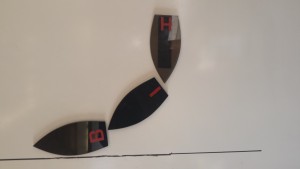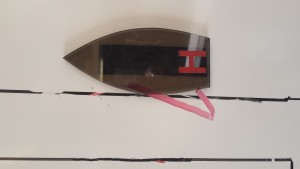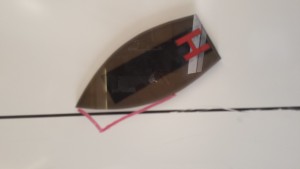Earlier, we looked at the D dock Pontoon Pump Station Bowen Basin. In this installment, we explore docking to leeward of the same dock. The choice of going to windward or leeward is entirely the skipper’s. Docking to windward is very easy, however the departure requires some effort. Docking to leeward can be challenging, but the departures are a piece of cake.
There are two basic techniques while going to leeward. Interestingly, the boat handling process is nearly identical. The only difference; with one the goal is to stop the boat parallel to the dock and with the other, try to stop with the bow almost touching and the stern a few feet out. The primary difference is how the lines are set up and handled. Both options require a dock line of about the same length as the length of the boat.
 To begin either docking option, approach the dock in forward at an angle. Depending upon circumstances, the angle can be anywhere from about 20 to 90 degrees. As the boat nears the dock, start a turn with the goal of bringing the boat parallel to the dock. To help me know when to turn, I use a simple visual trick. When the boat visually “touches” the dock, I begin my turn. When coming straight at the dock, this seems to be the spot that leaves just the right amount of space to complete a 90 degree turn without hitting the dock. All that is left is figuring out how fast to turn. Once the boat is along side the dock, option 1 or 2 below comes into play.
To begin either docking option, approach the dock in forward at an angle. Depending upon circumstances, the angle can be anywhere from about 20 to 90 degrees. As the boat nears the dock, start a turn with the goal of bringing the boat parallel to the dock. To help me know when to turn, I use a simple visual trick. When the boat visually “touches” the dock, I begin my turn. When coming straight at the dock, this seems to be the spot that leaves just the right amount of space to complete a 90 degree turn without hitting the dock. All that is left is figuring out how fast to turn. Once the boat is along side the dock, option 1 or 2 below comes into play.
 Option 1: Cleat hitch the line to a waist cleat. Bring the boat to a stop parallel to the dock and get the line around a dock cleat more or less even with the transom. Secure the line at the waist cleat (or a convent winch) and place the boat in forward at a low RPM. The force of the propeller against the line moves the boat towards the dock. Slow the approach by turning away from the dock; speed the approach by turning toward the dock.
Option 1: Cleat hitch the line to a waist cleat. Bring the boat to a stop parallel to the dock and get the line around a dock cleat more or less even with the transom. Secure the line at the waist cleat (or a convent winch) and place the boat in forward at a low RPM. The force of the propeller against the line moves the boat towards the dock. Slow the approach by turning away from the dock; speed the approach by turning toward the dock.
 Option 2: This option only works when placing the “prop walk side of the boat” against the dock. Tie a loose loop of line from the bow cleat to the waist cleat. Bring the bow as close to a dock cleat as possible and hold position. Use a boat hook to place the loop around the cleat. Reverse at a low RPM and let the prop walk bring the boat slowly to the dock.
Option 2: This option only works when placing the “prop walk side of the boat” against the dock. Tie a loose loop of line from the bow cleat to the waist cleat. Bring the bow as close to a dock cleat as possible and hold position. Use a boat hook to place the loop around the cleat. Reverse at a low RPM and let the prop walk bring the boat slowly to the dock.
Departures can’t be any easier. Cast off the dock lines and let the wind blow you away. Once cleat motor off.
My own personal choice is to dock to leeward whenever possible. I find it easier to dock to leeward than depart to windward. Your choice is yours, however, as you can see, the choice doesn’t involve “U turns” in close quarters situations.

In Option 1, do you run the waist (mid-ship) spring line back to the same waist (mid-ship) cleat it started or to a cleat (or winch) at the stern? The triangle in the image suggest you run it back to the stern. Or is that just a breast line you use to keep the stern in once you come to a stop?
Hi Ilian
You can do it either way. I personally like to lead it to a strong point near the stern, because it can be done from the cockpit. Taking it back to the waist cleat works just as well, especially if a crew member is handling the line.